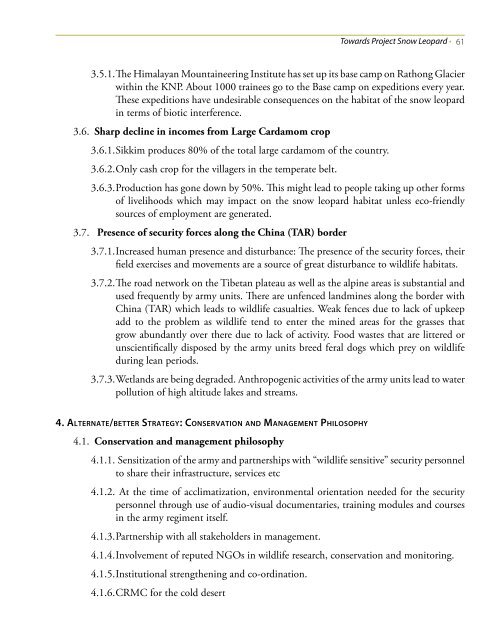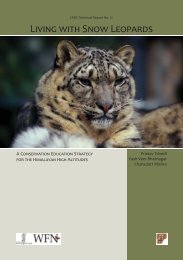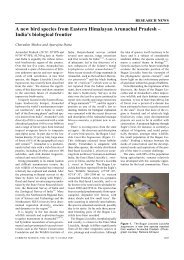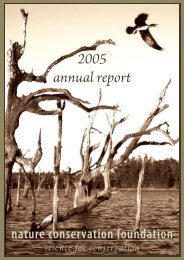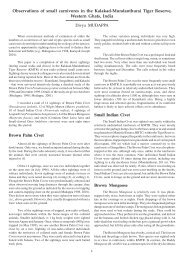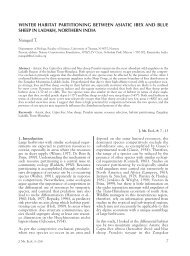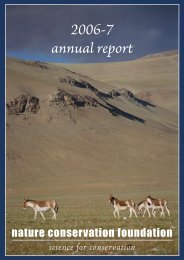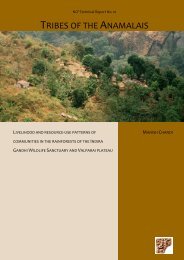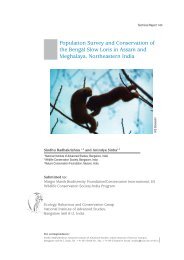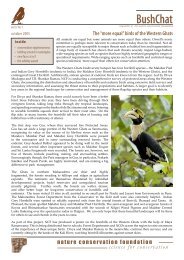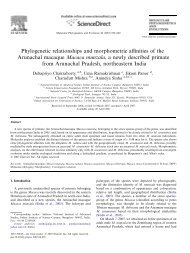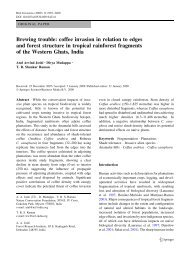towards project snow leopard - Nature Conservation Foundation
towards project snow leopard - Nature Conservation Foundation
towards project snow leopard - Nature Conservation Foundation
You also want an ePaper? Increase the reach of your titles
YUMPU automatically turns print PDFs into web optimized ePapers that Google loves.
Towards Project Snow Leopard • 61<br />
3.5.1. The Himalayan Mountaineering Institute has set up its base camp on Rathong Glacier<br />
within the KNP. About 1000 trainees go to the Base camp on expeditions every year.<br />
These expeditions have undesirable consequences on the habitat of the <strong>snow</strong> <strong>leopard</strong><br />
in terms of biotic interference.<br />
3.6. Sharp decline in incomes from Large Cardamom crop<br />
3.6.1. Sikkim produces 80% of the total large cardamom of the country.<br />
3.6.2. Only cash crop for the villagers in the temperate belt.<br />
3.6.3. Production has gone down by 50%. This might lead to people taking up other forms<br />
of livelihoods which may impact on the <strong>snow</strong> <strong>leopard</strong> habitat unless eco-friendly<br />
sources of employment are generated.<br />
3.7. Presence of security forces along the China (TAR) border<br />
3.7.1. Increased human presence and disturbance: The presence of the security forces, their<br />
field exercises and movements are a source of great disturbance to wildlife habitats.<br />
3.7.2. The road network on the Tibetan plateau as well as the alpine areas is substantial and<br />
used frequently by army units. There are unfenced landmines along the border with<br />
China (TAR) which leads to wildlife casualties. Weak fences due to lack of upkeep<br />
add to the problem as wildlife tend to enter the mined areas for the grasses that<br />
grow abundantly over there due to lack of activity. Food wastes that are littered or<br />
unscientifically disposed by the army units breed feral dogs which prey on wildlife<br />
during lean periods.<br />
3.7.3. Wetlands are being degraded. Anthropogenic activities of the army units lead to water<br />
pollution of high altitude lakes and streams.<br />
4. Alternate/better Strategy: <strong>Conservation</strong> and Management Philosophy<br />
4.1. <strong>Conservation</strong> and management philosophy<br />
4.1.1. Sensitization of the army and partnerships with “wildlife sensitive” security personnel<br />
to share their infrastructure, services etc<br />
4.1.2. At the time of acclimatization, environmental orientation needed for the security<br />
personnel through use of audio-visual documentaries, training modules and courses<br />
in the army regiment itself.<br />
4.1.3. Partnership with all stakeholders in management.<br />
4.1.4. Involvement of reputed NGOs in wildlife research, conservation and monitoring.<br />
4.1.5. Institutional strengthening and co-ordination.<br />
4.1.6. CRMC for the cold desert


